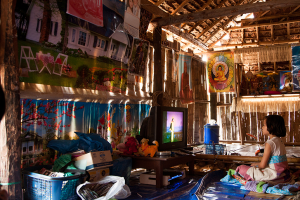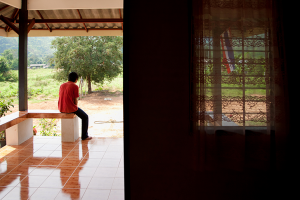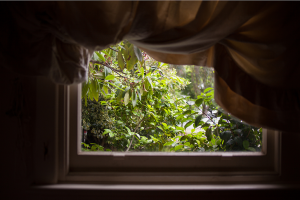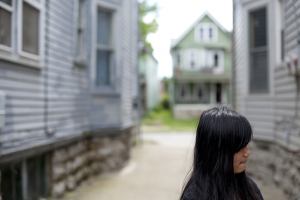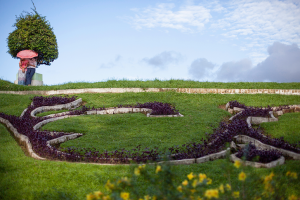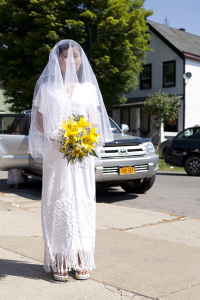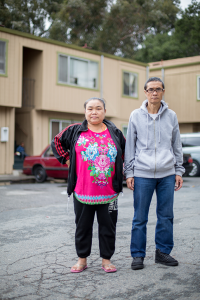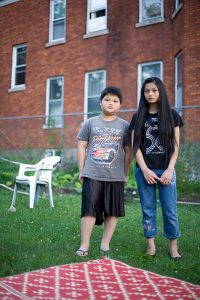Featured in
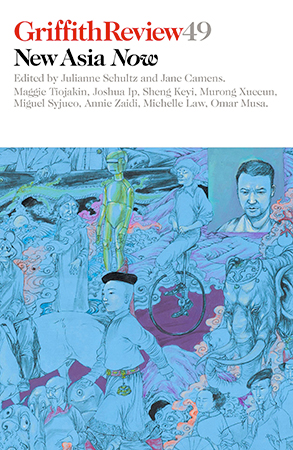
- Published 20150804
- ISBN: 978-1-922182-90-6
- Extent: 264 pp
- Paperback (234 x 153mm), eBook
IN RETROSPECT, IT was inevitable. But I know now there couldn’t have been a better place to have a racial epiphany than the buffet table. Apart from the fact that it was my parents’ favourite dining genre, it was also – let’s face it – the closest simulacrum of cultural diplomacy. There’s something oddly utopian about seeing piles of salt-and-pepper squid sitting inexplicably along- side shrunken frittatas and ‘French’ country stews. Under the heat lamps of the bain-maries all nations are equal.
It was the early ’90s, and our first school holidays in Australia. To celebrate, Mum and Dad had surprised us with a week-long trip to Brisbane with a dozen or so Chinese strangers who shared their passion for languorous naps and competitively priced coach tours.
My sister and I were the only kids in the group. By nightfall, we were thoroughly sick of each other. The twelve-year-old me knew it was time to find a new ally – someone else who was alone and alert to the threat of in-bus karaoke. My ally was a woman in her early thirties. She was holidaying from Hong Kong and spoke to me in English-spliced Cantonese. ‘You have an excellent accent,’ she said. (It was mildly Ameri- can at the time.) She declared it ‘authentic’ because it was the kind you heard on all the popular TV shows. This made me beam with pride. That she was smart and worldly made it all the more surprising when, one morning, a heated argument broke out between her and the hotel staff. At the breakfast buffet, a waiter had abruptly ushered her back to ‘our area’. Our tour group, apparently, was to eat from the Asian section. Continental breakfast, which our competitively priced package didn’t cover, was strictly out of bounds. It didn’t matter that my friend was headed for the bathroom and not the home-brand toast – all the waiter saw was a Chinese woman trying to get away with what wasn’t hers. In a split second, he’d turned the room into a Venn diagram of white faces and petty thieves.
‘WE ARE ALL savages inside. We all want to be the chosen, the beloved, the esteemed.’ Though the opening line of one of Cheryl Strayed’s best-loved ‘Dear Sugar’ advice columns deals with the origin of insatiable jealousy, her words nonetheless speak to our most private agony. And it boils down to this: it hurts to feel invisible, to have our complexities trampled upon, to suspect someone else’s needs are being tended to while we wait with growing frustra- tion for our turn to come along.
To fight the fate of invisibility, we become experts at cutting and re-cutting the highlight reel of our social selves. We remind each other we are aspiring food photographers/occasional (half) marathon runners/reality TV hate-watchers/ long-black-with-a-dash-of-cold-milk-drinkers. But in a crush of 7.2 billion bodies, how many glossy life trailers can we realistically expect to see?
Instead, we take to scanning a sea of faces like an endless Rorschach test. Our first impressions, in a sense, are also by-products of our innermost prejudice and fears.
In his widely shared New York Magazine essay ‘Paper Tigers’, Korean– American writer Wesley Yang describes an unsettling disconnect between his appearance and personal identity. Thanks to a lifelong wariness of Asian stereotypes, Yang has come to feel alienated from his own face. ‘Sometimes I’ll glimpse my reflection in a window and feel astonished by what I see,’ he writes. ‘What I feel in these moments is its strangeness to me. It’s my face. I can’t disclaim it. But what does it have to do with me?’
The internal world of Yang, like that of many immigrants, is more a product of the culture he grew up in than his ‘racial roots’. Yet his Asian features – the visible legacy he inherited – nonetheless continue to define him to strangers on the street. Here is what the acclaimed writer suspects his face signifies to others: ‘An invisible person, barely distinguishable from a mass of faces that resemble it. A conspicuous person standing apart from the crowd and yet devoid of any individuality… Not just [part of a] people “who are good at maths” and play the violin, but a mass of stifled, repressed, abused, conformist quasi-robots who simply do not matter, socially or culturally.’
AND YET, DESPITE sharing some of Yang’s anxieties, sometimes I forget I am Asian. Working in a predominately white newsroom I’d go for days, even weeks at a time without giving a thought to the colour of my skin – until someone reminds me casually, offhandedly. These sporadic reminders often catch me by surprise. Like the time I overheard a workmate’s complaint about her Chinese nanny’s ‘distressing’ accent, or when, more than once, I’ve had to break the news to fellow colleagues – sometimes mid-conversation – that I wasn’t the executive assistant, the other Asian employee with short hair in the office. To quote American screenwriter Justin Simien’s satirical book Dear White People (Atria, 2014): ‘Since falling out of vogue, blatant lynch-mob style expressions of racism have slowly morphed into more subversive forms.’ These days, it’s not so much the occasional mad, racist rants on public transport that trouble us. For the vast majority of non-white Australians, it’s what lurks beneath the polite bubble wrap of subtle, everyday microaggressions that causes more disquiet. Coined by psychiatrist Chester M Pierce in 1970, the term ‘microaggression’ refers to any ‘brief and commonplace verbal, behavioural or environmental indignities that communicate hostile, derogatory or negative racial slights and insults toward people of colour’. Think of it as the reverse Eat Pray Love (Penguin, 2006), if you will. Only instead of a white, middle-class woman’s journey to lose herself through the delicious culture shock of exotic climbs, imagine a trio of Italian, Indian and Indonesian immigrants arriving in an Anglo-Saxon country, constantly being bombarded by subtle messages that they are different, never allowed to forget their outsider status. What makes microaggressions tricky to deal with is that the comments are often made by well-meaning folks who have no idea they are causing offence. For many Asian–Australians, these subtle reminders can range from the gently stereotypical assumption that you can magically split the group dinner bill, an unabated interest in ‘where you are actually from’ or the suspicion that you are, and always will be, a rival in the property and selective school markets.
The bottom line, says Simien, is that this can cause a sense of paranoia for members of marginalised groups who ‘suspect oppression but feel guilty bring- ing it up and worry about being falsely accused of using the “race card”’. Or worse, simply being told to lighten up.
HERE’S SOMETHING I can’t help but wonder: if our racial identity is defined not only by who we are, but also who we’re not, then surely all migrant Australians must carry with us a human-sized dent of ‘whiteness’ in our shadow selves?
That was the kind of question I would’ve liked to ask my Smash Hits pen-pal Rebecca, back in Year 9. Instead, under the pen name ‘Antonia’, I was too busy mentally cataloguing what being a non-minority kid feels like. For example, Rebecca told me:
Friday: ‘I’m having the greatest time ever. My folks are down in Melbourne and I’m here all on my own. This is the life. Me and David, a Beam bottle, a Cougar bottle, each other, the stereo blast- ing (Nirvana + Alanis Morissette) and the place all to ourselves (and the dog). We are just making homemade pumpkin soup for tea…’
School: ‘I couldn’t give a flying fuck what my parents want me to do. At one stage when my dad was cracking a major fuss, I nearly took off with the circus. Ultimately I want to be a teacher but it’s a total utter fantasy land dream.’
While her letters were tiny glimpses of a life that felt as far-fetched as it did fictional, it wasn’t until years later that I understood being ‘white’ has less to do with the way you look, or what you do and eat, but the unqualified comfort you feel in your own skin. It’s the sum of suburban domesticity, the heady smell of vinegar and hot crinkle-cut chips, the Kelly Slater and Dieter Brummer posters on your bedroom walls – the lake of collective memories that brims over every time a stranger catches sight of your face.
Interestingly, it seems like that sense of radical comfort can be nourished. At a Sundance Festival panel this year, Indian–American actress and showrunner Mindy Kaling said: ‘I have a personality defect where I refuse to see myself as an underdog. It has gotten me into a lot of trouble but is also the reason for my success. I am often reminded of it when people ask me why I’m confident. Why wouldn’t I be? It’s because my parents raised me with the entitlement of a tall, blonde, white man.’
My parents never brought me up this way. But I’d already had a taste of what that feels like in my childhood in Hong Kong: when everyone at school, on the street, on TV and on the radio looked and sounded – reassur- ingly – like me.
THE DEBATE ON whether or not we have arrived at a post-racial world always reminds me of US comedian Hannibal Buress’s ‘discount apple juice’ joke. Buress, an apple juice lover, recalls the day he spotted a great deal at the supermarket. Excited by the dollar-a-litre juice sale, he grabbed eight bottles with his girlfriend – before noticing an old man shaking his head at them at the checkout: ‘I’m like, “What’s wrong, old man? You mad cause we got all this apple juice?… ’Cause hell yeah I’m hoarding this juice, taking advantage of this before the store realises what a horrible mistake they’ve made.”’ It wasn’t until later that he realised he’d completely misread the situation. The old man wasn’t shaking his head because of the apple juice. He was shaking his head because Buress was black and his girlfriend was white: ‘But I was so caught up in the euphoria of having all that apple juice that for a minute I lived in a world where racism didn’t exist.’
Indeed, when we look at our own multicultural society, it’s tempting to assume – as Buress did – that we are long past the point of old-fashioned racial bigotry. After all, how can we possibly be intolerant if there are more ethnic faces than ever in Australian schools, workplaces and on TV? How could we not be bathing in the bain-maries of goodwill when so many of us can judge the authenticity of a good pad thai, bahn mi or bibimbap? How can we not be champions of diversity if our cities are home to so many interracial couples and their supernaturally beautiful kids?
Well, it’s because the numbers tell a completely different story.
In 2010, an Australian National University study found that in order to get the same number of job interviews as a white Australian for an entry level role, someone with a Chinese last name will have to apply for 68 per cent more jobs. The figure is 64 per cent for applicants with Middle Eastern- sounding names and 35 per cent for Aboriginal counterparts.
Then there is the latest Mapping Social Cohesion survey by the Scanlon Foundation, which found 19 per cent of Australians were discriminated against because of their skin colour, ethnic origin or religious beliefs – the highest ever since 2007. Meanwhile, a 2014 Deakin University study revealed four out of five high school students born in non-English speaking countries experience racist taunts at least once a month.
Without question, these are sobering statistics. But to borrow from US Secretary of Defense (and conservative mascot) Donald Rumsfeld, it is the ‘unknown unknowns’ that should spark alarm. In other words, try as we may to measure overt discrimination, it’s impossible to count the number of opportunities you weren’t given if you had no idea they existed in the first place.
In the same way that glass ceilings exist for women, experts argue that when it comes to ethnic Australians being locked out of leadership positions – and, by extension, mainstream culture at large – there is a worrying level of ‘unconscious bias’ at play.
‘Western culture has long entertained the trope of the invisible, inoffensive and submissive Asian,’ said Race Discrimination Commissioner Tim Soutphommasane in a 2014 speech. The same destructive stereotype, presumably, that explains why, despite the fact that Asian–Australians represent 11 per cent of the population, only 1.9 per cent of execu- tive managers and 4.2 per cent of directors have an Asian background. It’s tempting to fancy ourselves colourblind just because we happen to live in a multicultural society. But wouldn’t it be a shame to fall into a post-racial slumber when the trappings of true diversity are practically within our reach?
Share article
About the author

Candice Chung
Candice Chung is the editor of Fairfax’s feminist website Daily Life. Her work has appeared in the Sydney Morning Herald, the Age, Sunday Life,...
More from this edition

We’re all Asian now
Introduction‘I’M NOT ASIAN and never will be,’ wrote Canadian author Karen Connelly in her Thai memoir, Touch the Dragon (Turnstone Press, 1992). ‘But,’ she...

Half a butterfly
ReportageTHE FIRST FEW days I stayed in Dona Paula, I was having a really hard time finding the beaches I’d heard about. My companions...

